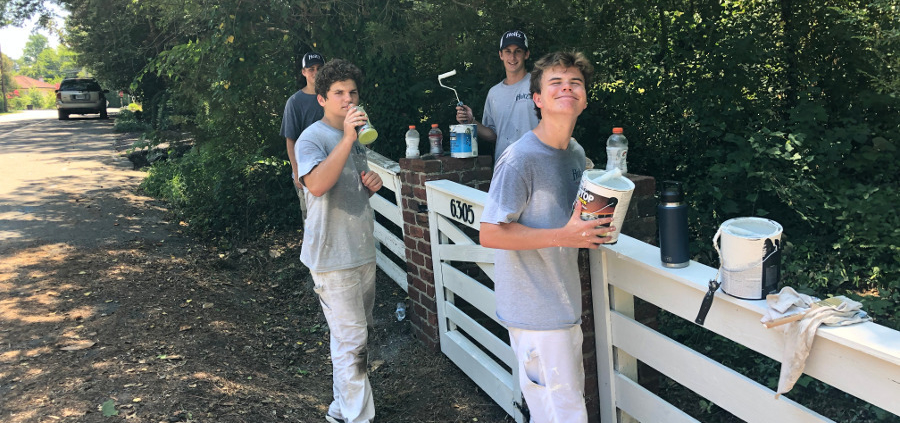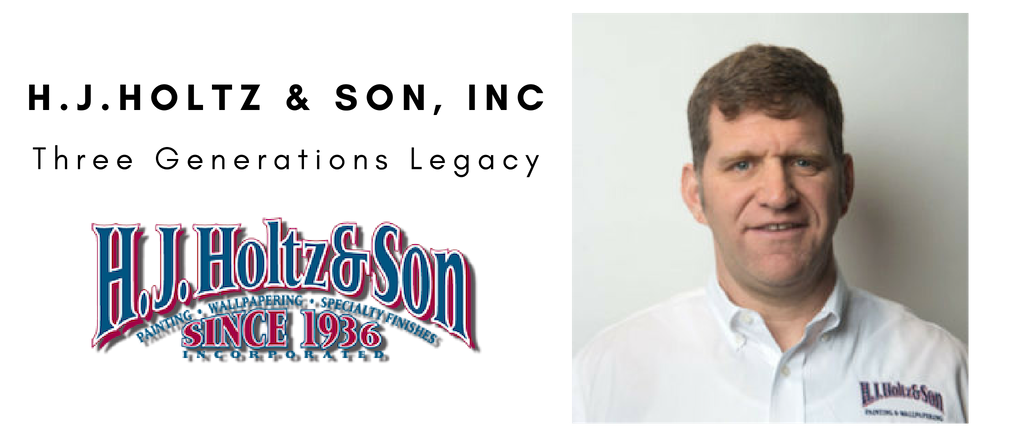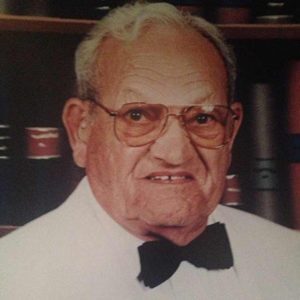
by HJ HOLTZ | Oct 23, 2019 | Employees, Wallcoverings
Continuing Education for our Paper Hangers
Shane Legano and James Draine, experienced paper hangers with H.J. Holtz & Son, are already implementing strategies they saw at the Wallcovering Installers Association annual convention last month.
Draine, who has been with the company for more than 15 years, says that within three days of his return to Richmond, he used an idea from the convention: scoring the back side of commercial wallpaper – thicker than most papers used in homes – so it more easily and crisply wraps around an outside corner. (An outside corner is where two walls meet and form an external angle, creating an edge to walk around).
“The knowledge I get [at this meeting] is great,” Draine says. “The tips and tricks we see there really come in handy.”
Legano agrees. “The different techniques other people have come up with make wallpaper jobs go smoother,” he says. “We learn so much every time we go.”
Legano, who has also been with H.J. Holtz & Son more than 15 years, says the easy atmosphere of the convention fosters support among participants, who share project stories without reservation. “Everybody’s open, nobody’s competing with each other,” he says, adding that participants develop working relationships that continue well beyond the convention.
“We reach out to each other through the year,” he says. “It’s a family-type organization. We like catching up [with friends]; we always look forward to it.”
Draine says he thinks the camaraderie at the convention is possible because the national pool of wallhanging professionals is relatively small. “You don’t have a lot of people in each state who do the work that we do,” he says. “Paper-hangers aren’t a dime a dozen; that brings us closer.”
Both craftsmen agree that attendance at the annual meeting has ripple effects, noting that the support of company president Rick Holtz is much appreciated. “Rick doesn’t have to send us, but the knowledge we bring back helps us and the company in the long run,” Legano says. Draine notes that for most other companies, it’s the owner who attends, not the paper hangers themselves. “[The instruction] saves us so much time and money,” he says, “and it makes our jobs look better, which is what really matters.”
It’s essential to keep skills sharp, they agree, because wallpaper and other coverings are more popular than ever. Customers can choose from a wide variety of materials and patterns – everything from fabrics to wood veneers to thick, patterned paper. “It’s instant gratification,” Legano says. “You can wrap anything. Just last week, James wrapped a trash can.”

by HJ HOLTZ | Sep 24, 2019 | Employees
Summer is always a busy time for H.J. Holtz & Son, as clients explore ways to freshen or re-imagine their living spaces. To help with the added workload – as well as to cultivate a next generation of craftspeople – the company annually hires a crew of teen and young adult workers, who learn alongside Holtz’s experienced team members.
This year’s summer crew was composed predominantly of high school students, with one returning college student. Four summer workers were related to Holtz staff members – including both of company president Rick Holtz’s sons.
“We love our summer crew,” Holtz says. “They bring great energy, and they are always eager to learn. Plus, they let our experienced craftspeople focus on the technical tasks only they can do.”
Turner J., a student at Roanoke College, returned for his second summer with the company because he had a good experience in 2018 and was expecting the job to be familiar. Some things were the same, he says, but others were different.
“I was really surprised by how much work I put in,” he says, noting that he spent much of this summer at a job in Williamsburg. With his work days made longer by travel time, Turner says, he learned how to rearrange his evening schedule so he could meet his summer running goals.
Pace F., a high school senior, says he came to Holtz & Son because he expected to learn – and he did. “I did everything from painting fences to removing shutters and wallpaper,” he says, adding that one job in particular – the restoration of an historic mural in the Beth Ahabah synagogue sanctuary – showed him how detailed and precise some tasks are.
“I learned how much planning goes into each project,” he says. “There is so much that is done to make sure that each job is running smoothly and everything is taken care of.”
Another senior, Evan B., says he came to Holtz & Son because he was tired of lifeguarding and was looking to do “something with my hands.” He was still outside, but mostly painted fences and siding, instead of sitting at a guard post.
“Something I learned this summer was the importance of hard work,” Evan says. “It really inspired me to see how hard all the full-time guys worked. It makes me want to work that hard in whatever job field I go into after college.”
Rick Holtz says everyone at Holtz & Son enjoys having summer workers around, because they remind existing team members what it was like to be new on a job.
“We all think a little more about what we do and why we do it,” he says. “When you teach someone, you’re refreshing your own skills.”

by HJ HOLTZ | Sep 14, 2019 | Commercial Painting, Employees
Oscar Ayala, who has just celebrated 10 years of employment with H.J. Holtz & Son, believes that part of doing a job well is doing it neatly.
“I always like to have everything nice – how everyone looks, how they work,” he says. “I want each job to be the best.”
Ayala’s position as foreman means he coordinates project details between the main office and the work site, managing the site and handling unforeseen developments that necessitate quick responses.
“Sometimes, there are differences [to navigate,] but we always figure it out,” he says.
One recent project that featured distinctive challenges was the Cedar Works apartment building, in Richmond’s Rocketts Landing neighborhood. The building, which had been part of a multi-structure manufacturing complex, was renovated and restyled with upscale apartments that featured bare brick walls and wood support beams.


Ayala spearheaded the painting of the building’s six levels (five residential floors and the basement), which necessitated working around the historic wood beams – some of which are said to have markings left by workers more than 100 years ago – and steering clear of exposed ceiling duct work.
Despite the obstacles, and residents, who were eager to see the project completed, Ayala says the job was a delight.
“I always like a big job because we get to work in one place for a while,” he says. “We do have to clean it every day – because people live there – but it was a good job. We just worked around everything.”
Ayala had worked as a painter for six years before coming to the company at the encouraging of several friends, who were then working for H.J. Holtz & Son. Even though Ayala was already an experienced painter, he had to learn the “Holtz ways” of doing things, he says. He was quickly promoted to foreman because of his ability to coordinate multiple tasks and keep projects on schedule.
“This company is one of the best in Richmond, and the painters are good to work with,” he says. Ayala says he enjoys his work because it’s always changing. “Every day, we learn something different,” he says, adding that he keeps abreast of new paints and techniques through videos and product classes.
In the end, he says, he enjoys both leading a team as well as delivering a finished project that will satisfy the client, noting “We want to make sure everything looks good.”

by HJ HOLTZ | Aug 26, 2019 | Employees
Every project, at its heart, is about fixing something that’s not right, says H.J. Holtz & Son President Rick Holtz.
“Customers bring us their problems, and we work with them to find solutions,” he says.
Solutions take many forms, but the Holtz approach is consistent, to ensure all customers receive the same attention that each job deserves.
Receptionist Susan Anderson, who joined the firm in 2018, is the first point of contact. She answers or returns customers’ calls and determines which Holtz estimator should respond. For wallpapering and decorative art projects, Anderson manages scheduling and communicates with customers about when work will begin.
“I like dealing with people,” Anderson says. “And I like our team; the people here are fun and easy to work with.”
Ricky Bryner, the company’s newest project estimator, says it’s important to learn what each customer’s specific needs are, so the company’s proposal is on point.
“Every project is different,” Bryner says. “It’s our job to listen and figure out what people want.”
Bryner, who joined H.J. Holtz & Son earlier this summer, has a background in construction staffing and project management, which he says will transfer well to estimating Holtz projects.
“My goal is to support the [company’s] reputation of being a leader in this business,” Bryner says.
Travis Gibson, who specializes in paint jobs, has been with the company for nine years and has worked his way from training as a painter to foreman to estimator. No matter what the job is, Gibson says, the goal is to provide accurate estimates about what a job requires.
“I don’t want to waste anybody’s time,” he says. “Because of the experience we have [as a company], we can sometimes suggest another route and explain why that would be better.”
Ultimately, Gibson says, the customer makes the call. “I want people to be comfortable in their house,” he says. “I don’t live in the house; that’s their space.”
Shane Legano, who has been with the firm more than 15 years, didn’t expect to add estimating to his skill set. “I love hanging wallpaper and being out in the field – seeing the beautiful wallpapering and specialty finishes that come at the end of the project,” he says.
Legano moved into estimating as he was recovering from a car accident; his injuries prevented him from the labor of hanging paper for a while. Now, he straddles both worlds. “I get to meet with clients, decorators and designers,” he says. “And, sometimes, I even get to work on the projects I’ve estimated, so I can see a project from the start to the end.”
Having a thoughtful and thorough estimating process is important both for clients and the company, Holtz says. “Our estimating team isn’t about selling the job,” he says. “We’re about letting customers know what we can do with our experienced craftspeople and what that will cost. We want to anticipate unforeseen issues and make the process go smoothly for everyone.”

by HJ HOLTZ | Apr 17, 2019 | Employees
Mark Woodson is celebrating his 15th year work anniversary at H.J. Holtz & Son Painting and Wallpapering this month. But for a slight detour, it could be a 20-year anniversary.
Fifteen years ago, Woodson was presented with a job opportunity that appeared to be even better than the position he had at the time. So he left Holtz & Son. Four years later, he was back. “I thought [the other job] was a better opportunity, but it wasn’t,” he says now. “I knew that I’d left a good company, and I knew what I could come back to: plenty of work, good-hearted people, a good family.”
Woodson first came to the painting company at the recommendation of his brother, who was already at Holtz & Son. He started as a helper, prepping paint projects. He trained to become a painter and is now one of the company’s foremen, responsible for managing painting jobs on-site. Woodson says he enjoys the camaraderie among Holtz staff. “We’re here to do whatever it takes to get [the job] done as a team,” he says.
Recently, one of the other painters moved into a different role in the Holtz front office. Though his former fellow painter is now, technically, his supervisor, Woodson says it’s been an easy transition. “He took the initiative to take that challenge on,” he says. “But it’s been great so far. We’re still friends.”
When another Holtz employee left the firm nearly a decade ago, Woodson stepped into the job of spray-painting cabinets, an in-house position that is crucial to ensuing that projects stay on schedule. He made the shift, he says, “because if it’s going to benefit the company, it’s going to benefit me.”
About 18 months ago, Woodson left the spray room to return to on-site projects. “It’s a little freer than when you’re in the shop,” he says, noting the variety of tasks and challenges that come with specific jobs. “I can do the job to the best of my ability with no one looking over my shoulder.”
Company president Rick Holtz says Woodson has a fun-loving personality that makes work easier. “He’s serious about what he does – and he’s really good at it – but he also wants to have a good time, and he wants the guys working with him to have fun, too,” Holtz says.
Woodson says he enjoys the atmosphere that the company has fostered. “It’s a family-oriented business,” he says. “It’s all about quality, trust and understanding. [Management] doesn’t separate itself from the employees. You don’t find that very often.”

by HJ HOLTZ | Feb 19, 2019 | Employees
Only 12 percent of family businesses survive to a third generation. Only four percent make it to a fourth generation.
There are many reasons why a family business doesn’t continue, says Sam Davis III, director of the VCU Family Business Forum, an organization that seeks to support family ventures by providing educational and networking opportunities.
“Most businesses end because of market conditions or no family member wants to continue,” Davis says. “But there’s a body of knowledge about multi-generational family businesses that all too few know exist or are schooled in. It’s our goal to educate family businesses about the best and worst practices as well as a conceptual understanding of how family businesses are different from other businesses.”
The group’s monthly meetings, held September through May, feature speakers on a variety of business and financial planning topics and occasionally are multi-generational business owners themselves.
“Members learn as much from each other as from our speakers,” he says. “They are more likely to implement what they’ve learned from a peer.”
Last year, one of those speakers was H.J. Holtz & Son owner Rick Holtz. “Rick is a third-generation owner of a unique business, succeeding against all odds,” Davis says. “His is a fragmented industry. His business morphed from his grandfather hanging paper, then to painting, now adding back the hanging of paper. That’s pretty unique – to stay in the same line of business. He has very compelling story and was very well received by our Family Business Forum audience of his peers.”
In his remarks, Holtz talked about how the family business survived the varying approaches taken by different family members. His grandfather, Herman J. Holtz, was a “jack of all trades” who would pull in workers as needed for projects and was always on the lookout for new customers and jobs. By contrast, Rick’s father, Richard Holtz, Sr., wanted smaller, high-end clients, focusing on the residential market.


When Holtz Sr. bought the business in 1971, Herman Holtz opened his own woodworking shop, and his son, the new owner, whittled the staff to a smaller, more specialized team, which at times included his own son, Rick.
Rick Holtz started working for the business when he was 13. Rather than join the firm right after high school, Holtz went to Virginia Tech and majored in urban affairs and planning, with no intention of taking over the family business. “After graduation, I went to work for the state,” he says. “After that year, the program wasn’t renewed, and I didn’t have a job.”
Needing something to do, Holtz began working as a painter for H.J. Holtz & Son. Soon, he had a serious conversation with his grandfather, who assured him he could take on the family business and make it his own, telling his grandson, “This business can be anything you want it to be. Be a business person.”
With that encouragement, Holtz joined the company full-time in 1995 and bought the business from his father in 2007.
Holtz liked his father’s model of building relationships with customers and others in the industry, but described his first years at the helm as “controlled chaos.” After surviving the Great Recession of 2008-2009, Holtz recognized he needed a fresh approach. “I changed my mindset from working in my business to working on my business,” he says. “I was running my parents’ company even though it was mine.”
Holtz hired a business coach, a marketing professional, and a financial planner. Together, the team developed an employee-driven philosophy that includes caring for one another, caring for customers, and making money.
Along the way, Holtz says, he learned some simple truths:
- You’ve got to spend money to make money.
- You don’t need to be the man or the woman in charge; you can be one of many contributors.
- Discipline and follow-through are important.
- Find issues in your company that don’t have owners. Find owners for those issues and you’ll have fewer problems.
And finally:
- Success is scary and can be as uncomfortable as failure. Take courage to relish success and treat it as the new norm.
In the end, Holtz says, he’s exactly where he should be. “I was destined to be in the industry from the time I was a little kid with my dad to when I used to work in the summers,” he says. “I’m always trying to find opportunities for my employees and my business. I was grateful to be able to share our story with the Family Business Forum members.”










